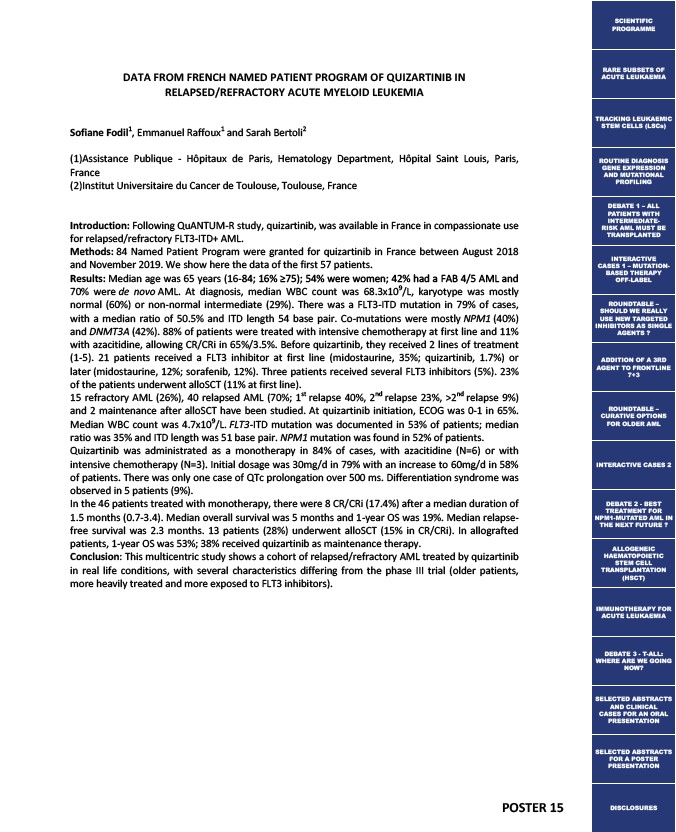
POSTER 15
DATA FROM FRENCH NAMED PATIENT PROGRAM OF QUIZARTINIB IN
RELAPSED/REFRACTORY ACUTE MYELOID LEUKEMIA
Sofiane Fodil1, Emmanuel Raffoux1 and Sarah Bertoli2
(1)Assistance Publique - Hôpitaux de Paris, Hematology Department, Hôpital Saint Louis, Paris,
France
(2)Institut Universitaire du Cancer de Toulouse, Toulouse, France
Introduction: Following QuANTUM-R study, quizartinib, was available in France in compassionate use
for relapsed/refractory FLT3-ITD+ AML.
Methods: 84 Named Patient Program were granted for quizartinib in France between August 2018
and November 2019. We show here the data of the first 57 patients.
Results: Median age was 65 years (16-84; 16% ≥75); 54% were women; 42% had a FAB 4/5 AML and
70% were de novo AML. At diagnosis, median WBC count was 68.3x109/L, karyotype was mostly
normal (60%) or non-normal intermediate (29%). There was a FLT3-ITD mutation in 79% of cases,
with a median ratio of 50.5% and ITD length 54 base pair. Co-mutations were mostly NPM1 (40%)
and DNMT3A (42%). 88% of patients were treated with intensive chemotherapy at first line and 11%
with azacitidine, allowing CR/CRi in 65%/3.5%. Before quizartinib, they received 2 lines of treatment
(1-5). 21 patients received a FLT3 inhibitor at first line (midostaurine, 35%; quizartinib, 1.7%) or
later (midostaurine, 12%; sorafenib, 12%). Three patients received several FLT3 inhibitors (5%). 23%
of the patients underwent alloSCT (11% at first line).
15 refractory AML (26%), 40 relapsed AML (70%; 1st relapse 40%, 2nd relapse 23%, >2nd relapse 9%)
and 2 maintenance after alloSCT have been studied. At quizartinib initiation, ECOG was 0-1 in 65%.
Median WBC count was 4.7x109/L. FLT3-ITD mutation was documented in 53% of patients; median
ratio was 35% and ITD length was 51 base pair. NPM1 mutation was found in 52% of patients.
Quizartinib was administrated as a monotherapy in 84% of cases, with azacitidine (N=6) or with
intensive chemotherapy (N=3). Initial dosage was 30mg/d in 79% with an increase to 60mg/d in 58%
of patients. There was only one case of QTc prolongation over 500 ms. Differentiation syndrome was
observed in 5 patients (9%).
In the 46 patients treated with monotherapy, there were 8 CR/CRi (17.4%) after a median duration of
1.5 months (0.7-3.4). Median overall survival was 5 months and 1-year OS was 19%. Median relapse-free
survival was 2.3 months. 13 patients (28%) underwent alloSCT (15% in CR/CRi). In allografted
patients, 1-year OS was 53%; 38% received quizartinib as maintenance therapy.
Conclusion: This multicentric study shows a cohort of relapsed/refractory AML treated by quizartinib
in real life conditions, with several characteristics differing from the phase III trial (older patients,
more heavily treated and more exposed to FLT3 inhibitors).
SCIENTIFIC
PROGRAMME
RARE SUBSETS OF
ACUTE LEUKAEMIA
TRACKING LEUKAEMIC
STEM CELLS (LSCs)
ROUTINE DIAGNOSIS
GENE EXPRESSION
AND MUTATIONAL
PROFILING
DEBATE 1 – ALL
PATIENTS WITH
INTERMEDIATE-RISK
AML MUST BE
TRANSPLANTED
INTERACTIVE
CASES 1 – MUTATION-BASED
THERAPY
OFF-LABEL
ROUNDTABLE –
SHOULD WE REALLY
USE NEW TARGETED
INHIBITORS AS SINGLE
AGENTS ?
ADDITION OF A 3RD
AGENT TO FRONTLINE
7+3
ROUNDTABLE –
CURATIVE OPTIONS
FOR OLDER AML
INTERACTIVE CASES 2
DEBATE 2 - BEST
TREATMENT FOR
NPM1-MUTATED AML IN
THE NEXT FUTURE ?
ALLOGENEIC
HAEMATOPOIETIC
STEM CELL
TRANSPLANTATION
(HSCT)
IMMUNOTHERAPY FOR
ACUTE LEUKAEMIA
DEBATE 3 - T-ALL:
WHERE ARE WE GOING
NOW?
SELECTED ABSTRACTS
AND CLINICAL
CASES FOR AN ORAL
PRESENTATION
SELECTED ABSTRACTS
FOR A POSTER
PRESENTATION
DISCLOSURES